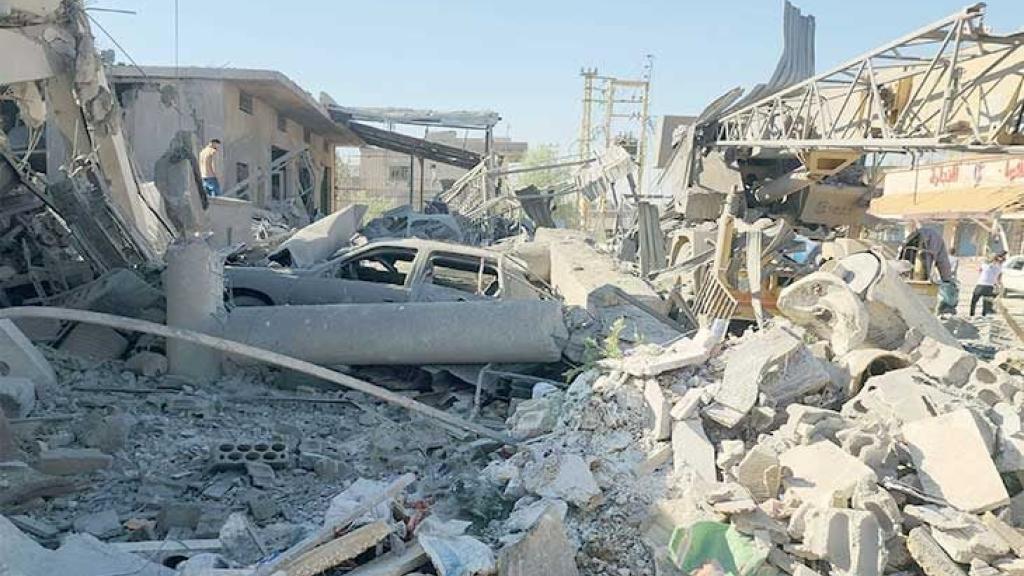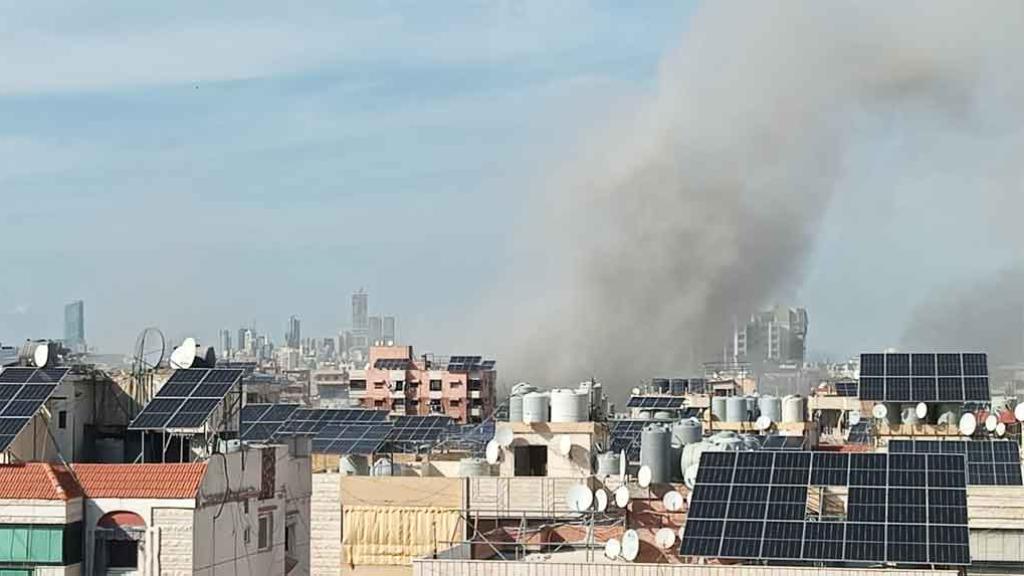Strategic reflections on the escalation of Israeli intimidation in Lebanon

First published in Arabic at Al-Quds al-Arabi. Translation from Gilbert Achcar's blog.
Not even an hour had passed after I wrote my article of a week ago (“Lebanon and the Israeli Strategy of Intimidation”, 17/9/2024) when the Israeli intelligence agencies launched a mass terror operation in Lebanon by blowing up individual communication devices in two successive waves over two days, killing more than 40 people and wounding more than 3,500. These two waves of mass terrorism were followed by an escalation in the exchange of shells across the border, between Hezbollah and the Israeli Aggression Forces (aka IDF), preluding to the intense violent bombardment that poured down on Monday on southern Lebanon and other areas where Hezbollah is present, killing nearly 500 people and wounding more than 1,600. The bombardment is still ongoing as these lines are written.
The question that imposed itself on everyone, starting with those targeted in Lebanon, is whether this sudden escalation in what we called the “Israeli strategy of intimidation” is paving the way for a full-scale aggression against Lebanon that would include indiscriminate heavy bombing of all areas where Hezbollah is present, including the densely populated southern suburb of Beirut, with the aim of making it “look like Gaza” in the words of one of Benjamin Netanyahu’s close associates. It is indeed feared that the Zionist state will carry out a brutal aggression on parts of Lebanon, similar to the aggression that targeted the entire Gaza Strip, in line with what one of the overseers of the Israeli aggression on Lebanon in 2006 called the “Dahiya doctrine” (a reference to the southern suburb of Beirut, the Arabic word dahiya meaning “suburb”). This doctrine aims at achieving deterrence against anyone who has the intention of confronting Israel, by threatening to inflict a high level of violence on areas inhabited by the civilian population to which those who nurture that intention belong, like what happened to the southern suburb of Beirut in 2006, which is the main area where Hezbollah’s popular base is concentrated.
It is a fact that the 2006 aggression that followed an operation carried out by Hezbollah fighters across the southern Lebanese border against Israeli soldiers, killing eight of them and capturing two, had a deterrent effect, which was acknowledged by the Hezbollah’s Secretary-General Hassan Nasrallah in declaring his regret, when he famously said on television in the aftermath of that war: “If I had known for one percent that this abduction operation would lead to a war of this magnitude, we certainly would not have done it for humanitarian, moral, military, social, security and political reasons.”
What the Western media, which are quick to condemn war crimes when they are committed by the West’s enemies, such as the Russian regime in Ukraine, do not say, is that the “Dahiya doctrine” is not an instance of military genius and a doctrine worthy of being taught in the military colleges of civilized countries, but rather a blatant violation of the laws of war, which consist in the practice of war crimes on a large scale, up to a genocidal level in Gaza, through an explicit intent to target civilians in order to deter combatants. It is, in other words, a terrorist strategy formulated by a terrorist state par excellence, which constitutes a stark confirmation that state terrorism is much more dangerous than the terrorism of non-state groups, as it applies the same logic, i.e. the killing of civilians for a political purpose, but with immeasurably greater potential for lethality and destruction.
Hezbollah learned two lessons from the 33-Day War in 2006. The first translates in that it has since then taken into account what it sees as a red line that, if crossed, would give the Zionist state a new pretext to attack Lebanese civilians. In order to ward off its popular base in the first place, Hezbollah did not carry out any bold operation like the one that sparked the 2006 war – or the one carried out by Hamas about a year ago, igniting the war to destroy Gaza and exterminate its people. The second lesson led Hezbollah to acquire a huge arsenal of missiles that established a counter-deterrent by threatening civilian areas inside the Zionist state, thus achieving what is called in the vocabulary of nuclear deterrence a “balance of terror”.
This equation is what explains Hezbollah’s initiative of starting a limited war of attrition with the Zionist state the day after Operation “Al-Aqsa Flood”, in response to Hamas’s call for it to join what it had initiated. That call came in a message from the military leader of the Islamic movement in the Gaza Strip, Muhammad al-Deif, broadcast at the start of the operation: “Oh our brothers in the Islamic resistance, in Lebanon, Iran, Yemen, Iraq and Syria, this is the day when your resistance will merge with your people in Palestine so that this terrible occupier will understand that the time in which it rampages and assassinates scholars and leaders has ended. The time of plundering your wealth has ended. The almost daily bombing in Syria and Iraq has ended. The time of dividing the nation and scattering its forces in internal conflicts has ended. The time has come for all Arab and Islamic forces to unite to sweep this occupation from our holy sites and our land.”
However, Hezbollah was smarter than to be overcome by euphoria to the point of believing that the day of victory over Israel and liberation of Palestine had come. It decided therefore to enter the battle as a supporter rather than a full participant, a decision that translated into the limited war of attrition. The party wanted to express its solidarity with the people of Gaza, but without exposing its popular base to a fate similar to that of the residents of the Strip. However, this calculation is now backfiring on Hezbollah, as the Zionist aggression army, having finished its intensive large-scale operations in Gaza, is now focusing on its northern front, launching what we called the “strategy of intimidation”, which is a gradual escalation in attacks with a threat to shift to implementing the “Dahiya doctrine”.
This Israeli behaviour demonstrates the effectiveness of Hezbollah’s counter-deterrence, as the Zionist government is forced to be cautious about igniting a full-scale war that it knows will be costly to Israeli society, even if the cost to Hezbollah’s base will be much higher given the great superiority of Israeli military capabilities. The Zionist government hence resorted first to escalation through “asymmetric warfare”, a term that usually describes the actions of an irregular force against a regular army. Here, it is the Zionist state that is dealing a devious and painful blow to Hezbollah and its civilian milieu by blowing up communications devices. This was followed by an escalation of conventional war that began on Monday, constituting a dangerous escalation of pressure on Hezbollah to force it to surrender and accept the conditions set by Washington with the approval of the Zionist government, the most important of which is the withdrawal of the party’s forces to north of the Litani River.
Confronted with this escalating pressure, the party finds itself trapped in mutual, but unequal, deterrence. It does not possess the capabilities of waging “asymmetric warfare” deep inside Israel and cannot strike there in a way that would cause hundreds of deaths, like what the Zionist army inflicted on Lebanon on Monday, for fear that the response would be overwhelming, knowing that Israel is fully capable of responding at a much higher level. The Zionist government is wholly aware of the conditions of the equation. While it wishes to dismantle Hezbollah’s deterrent capacity, it cannot initiate a comprehensive war without ensuring full US participation in it, similar to Washington’s participation in the war on Gaza during several months, the most deadly and destructive months, to the point of countering all calls for a ceasefire. The Zionist government needs such full US complicity in the event of launching a full-scale aggression on Lebanon, the political conditions of which have not yet been met. It is working to achieve them, however, and may well issue a warning with a limited deadline to Hezbollah for that purpose, as we mentioned a week ago.
From all of this, it appears that Netanyahu has begun to fear that his friend Donald Trump might well fail in the upcoming US presidential elections in about a month and a half. It seems that he therefore decided to escalate matters, taking advantage of the last months of presence of his other friend, the “proud Irish-American Zionist” Joe Biden, in the White House. The question now is: will Biden pressure Netanyahu firmly enough to prevent a war that is likely to negatively affect the campaign of his party’s candidate, Kamala Harris, or will he once again go along with his friend’s criminal endeavour, even if accompanied by an expression of regret and resentment meant to deflect the blame in his and his Secretary of State Blinken’s usual hypocritical way?
Israel’s offensive against Lebanon represents an escalation of Netanyahu’s project of death

First published in Portuguese at Movimento Revista.
“Significant opportunities, heavy risks”. That was how Israeli defence minister Yoav Gallant, with his usual dose of sadism and lack of aplomb, defined Zionism’s new offensive in Lebanon. This new phase in Israel’s military operation across the Middle East — which has involved carrying out genocide in Gaza for almost a year— began with an unprecedented terrorist attack against Hezbollah at the start of last week. In two stages over two days, Mossad blew up thousands of pagers and walkie-talkies in Lebanese territory, killing about 40 people and leaving hundreds injured. Following this terrorist attack, Israel carried out a bombing raid on Beirut that hit Hezbollah targets and a school, killing 37 people (including 13 children).
Developing a deeper analysis of the dynamics behind Israel’s offensive in the Middle East is decisive for understanding the immediate future of global geopolitics, its central conflicts and developments. We have contributed to this effort through our contacts and publications, including with the recent interview we published (before the current offensive on Lebanon) with Lebanese Marxist intellectual and Middle East specialist Gilbert Achcar in Movimento Revista.
Right now, given the genocide in Gaza and the terrifying data accompanying it — for example, the fact that it is, proportionally, the largest child genocide in history — we need to understand three key elements: Israeli Prime Minister Benjamin Netanyahu’s real strategy, including it scope and limits; the military and diplomatic relationship of forces at the international level; and the capacity for popular and military resistance of the Palestinian, Lebanese and allied forces. Genocide is being imposed through killings, starvation and the multiplication of diseases such as polio.
Netanyahu is doubling down. Besieged by criticism and mobilisations, including a September 2 general strike and marches of more than 400,000 people on September 7 demanding negotiations to free the hostages, Netanyahu has no choice but to go on the offensive. Despite his rhetorical claims that his military objective is to neutralise Hamas, in reality Netanyahu and his closest allies want to redesign the map of the Middle East, with a new “Greater Israel” becoming a supremacist and colonial reference point for the global far right. Faced with this situation, in which the Palestinian resistance continues to fight, there has been a shift in the axis of focus in recent months: an offensive tied to the use of intelligence (including a series of assassinations, such as that of Hamas leader Ismail Haniyeh, and suspected participation in the death of Iranian President Ebrahim Raisi) and expanding the conflict to the whole region. Mossad had already planted the explosives used in the attack in Lebanon about two years ago — before its current offensive began on October 7. As Achcar wrote in his most recent article:
Netanyahu himself has contributed to the beating of the drums for the coming war on Lebanon, through one of his close associates in the Likud Party who attributed to him the intention to launch a war that will make the Beirut suburb “look like Gaza”.
On the other hand, the siege on Jenin corroborates an intensification of attacks in the West Bank. Brutal images have shown Israeli soldiers throwing Palestinians off high-rise buildings as part of this new offensive.
How has the United States — the main guarantor of the genocide in Gaza — responded? On one hand, it has sought to block countless United Nations resolutions calling for a ceasefire and condemning Netanyahu and the State of Israel; on the other, it is seeking to negotiate to avoid a regional war, given the uncertainty surrounding the November 5 presidential elections. President Joe Biden has been worn down, Kamala Harris wants to maintain her commitment to Zionism, and Donald Trump is a key Netanyahu ally when it comes to lending legitimacy to his “final solution”. The US faces a delicate situation, throwing everything it has to hold onto its geopolitical hegemony in the face of growing competition from China and the US capitalist class facing its biggest split in recent history.
The third element is how those fighting back on the ground will respond. Hezbollah has been dealt a heavy blow, both in terms of demoralising its intelligence service and the assassination of two of its main commanders, Ibrahim Aquil and Ahmed Wabbi. Anyone who saw Nasrallah’s statement after the offensive sensed a certain measured response, despite the increase in missile fire that was intercepted by the Israeli defence system. Recep Tayyip Erdogan again spoke out, calling on “Western nations” to avoid the worst, namely an escalation of the war. Iran condemned the offensive, but made no sudden military moves. The Houthis continue their maritime military operation, exchanging fire and consuming Israeli efforts on this front.
Hezbollah is the fruit of the aftermath of the long Lebanese civil war, part of the Shiite and Islamic movements that hegemonised the struggle against Zionism after the weakening of secular and national liberation movements. As one Spanish analyst put it, it is “bigger than a militia, smaller than a state”. The overall response of Lebanese society, fractured by wars and crises, will be decisive in ensuring the fight against the Zionist offensive does not just become a religious struggle in defence of Shiites.
The international response will also be fundamental. Bolstered by public opinion, ranging from UN resolutions to the International Criminal Court’s arrest warrant for Netanyahu, movements in solidarity with the Palestinian people must step up their efforts. Partial measures such as the suspension of Britain’s arms trade with Israel help weaken Zionism. This battle is also taking place on the domestic front in Brazil, around the campaign to suspend agreements with Elbit, to break diplomatic ties with Israel and strengthen the BDS campaign.
The offensive in Lebanon is an example of how far Netanyahu’s project of death, neo-colonialism and neo-fascism is willing to go. Solidarity with the Lebanese people is an integral part of our immediate program for stopping the supremacists who want to impose their “final solution” as a new standard for the dehumanisation of the other, thereby naturalising the catastrophe we confront on several fronts.
Israel Dutra is a sociologist, PSOL's Secretary for Social Movements and member of the party's National Directorate, and a member of the Socialist Left Movement (MES/PSOL) National Directorate.



 Figure 1. Total U.S. employment by workplace size, 2022.
Figure 1. Total U.S. employment by workplace size, 2022.